Connections – Food – Life – History
By Mary Stanley
We left our frozen dessert trail in Persia at about the time the Romans took over making what is now Italy as the center of civilized power – – the Persian Empire fell after it was conquered by Alexander the Great in 329 B.C. Alexander, a Macedonian, never defeated in war aspired to reach the “ends of the world and the Great Outer Sea”. He created one of the largest empires in history stretching from western India to the Adriatic down to Egypt all accomplished by the ripe old age of 30. Remember the map of the citrus trade routes? Those trade routes were now expanded and somewhat less dangerous to travel. Modern Macedonians and Greeks have sparred over which country gets to claim the history of ancient Macedonia as its own. As of February 2019, the country Macedonia is officially known as the Republic of North Macedonia.
Hellenization – the word – was created in modern times to describe the spread and integration of Greek language, culture, and population into the former Persian empire after Alexander’s conquest, Hellenization changed the known world. Alexander had been a student of Aristotle until he was 16, home schooling with the best of the best. Royalty has its advantages. Throughout this period, ancient Greece produced leaders in philosophy, mathematics, astronomy, and politics, Their legacy deeply influenced later Roman, Renaissance, and modern Western civilizations. When we talk about western culture, these folks are the original source. From the democratic ideals of Athens to the spread of Greek culture, the impact remains profound. Ancient Greece was never really an empire or a country but a loose coalition of independent city-states that shared cultural and religious beliefs. It was only in modern times (1821) that Greece become a country. The ideas and inventions produced by the ancient Greeks ended up becoming the foundation of our Western civilization, from the Archimedes screw and the understanding of many mathematical concepts to various philosophical ideas about what constitutes freedom and some awesome food.
A militaristic and prosperous Rome made it their goal to conquer all of Greece. In 146 BC Rome (under the command of Lucius Mummius) defeated a Greek armies at the Battle of Corinth. Rome then became the dominant force in the Mediterranean.
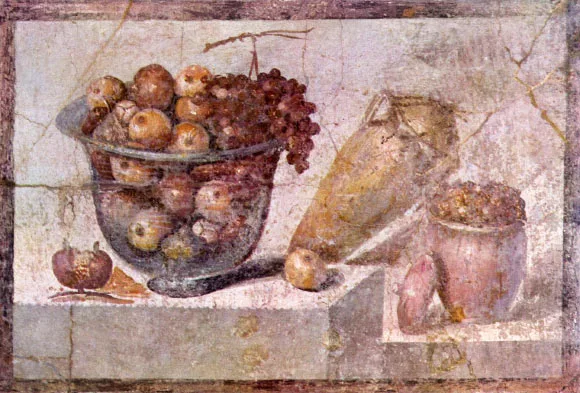
Not only did Rome absorb the various ancient Greece city-states into their empire, the Romans also kind of appropriated a great deal of Greek culture, including ancient Greek religious beliefs and gods. So, for example, the king of the Greek pantheon of gods Zeus became Jupiter in Rome; and the Greek god of war Ares became Mars in the pantheon of Roman gods. The Romans also adopted various aspects of Greek, Arabic, and Persian food culture, including the use of olive oil, wine, bread, and various spices and herbs in their cooking. Dessert wise there isn’t much evolution or innovation from the time of the Persian yakhchāl.
Citrus was being cultivated and evolving. It’s importance in trade which reflected increased use by the upper classes which had risen over the centuries. Cleopatra offered Marc Anthony and Cesare a frozen snow slushy made of snow and fruits when they visited her. These slushies must have been pretty seductive in addition to being luxurious because between the three of them, they had four children. That barge trip was something to write home about!

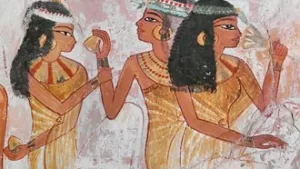
During the Roman era Mediterranean Sea cargo might be comprised of compacted snow from Mt. Etna and Mt. Vesuvius in route to Rome and was quite profitable. The icy concoction was not only popular with the aristocracy. Emperor Nero supposedly invented a device which held a glass tube that was filled with boiling water, then surrounded by snow to cool it. One assumes that the boiled water would be room temperature before surrounding it with snow. The general population were provided with the same delicacy but less sterile by street vendors who just used the snow directly. Pre Nero these snow drinks could be muddy and taste like the straw packaging it was shipped in. When Rome fell in 476 AD the frozen slushie disappeared from the Italian peninsula.
Around 710 AD, the Arabs re introduced this sorbetto or frozen snow back into the Spain and Sicily as their conquest of those lands proceeded. As John Bagnell Bury writes, “A fruitful land and a desirable possession in itself, Sicily’s central position between the two basins of the Mediterranean rendered it an object of supreme importance to any Eastern sea-power which was commercially or politically aggressive; while for an ambitious ruler in Africa it was the steppingstone to Italy and the gates of the Adriatic.” Money and Power are the supreme motivators, though not always ethical influencers.
In Northern Europe, knowledge of Arabic sorbetto was brought back by the Crusaders who had come to know it during their time in the Holy Land. During the Third crusade, legend claims that at Siege of Acre, Richard The Lionhearted became quite ill, Saladin, the first sultan of both Egypt and Syria, sent his personal physician, sorbetto, actually peaches, pears and snow with negotiators to Richard when Saladin learned his adversary was suffering from a fever, chivalrous indeed. “When Richard’s horse is killed during battle, and the English king finds himself on foot facing the entire Muslim army, the Muslims let him walk by their entire phalanx without attacking. Later, Saladin sends him two fresh mounts so he will not be at a disadvantage,” Saladin abided by a code of chivalry, for which he was renowned among Muslims and Christians alike. While in the short run this could In the long run this insistence on warrior ethics was very beneficial for Saladin who gained a reputation of a just ruler. This meant that his enemies could surrender to him with honor, instead of fighting to the death. Chivalry did not, however, keep either side from killing tens of thousands in battle. Richard the Lion Hearted and Saladin never actually met on the battlefield . This 1340 English manuscript is fake news.

The “Renaissance” history of gelato begins with the the Medici banking family whose wealth and power allowed them access to political power in Florence, but they were not regarded as equals by the aristocracy. In 1527, they were ousted, and Caterina de Medici spent three years living in convents, her life threatened at times because of her family name until Pope Clement VII called her to Rome in 1530 to arrange her marriage to the son of Francis I ,King of France, Henry, Duke of Orléans, Pope Clement VII saw this as an opportunity for a Medici to rise to aristocracy. Two fourteen year olds. The teen-aged couple was married in October of the 1533.
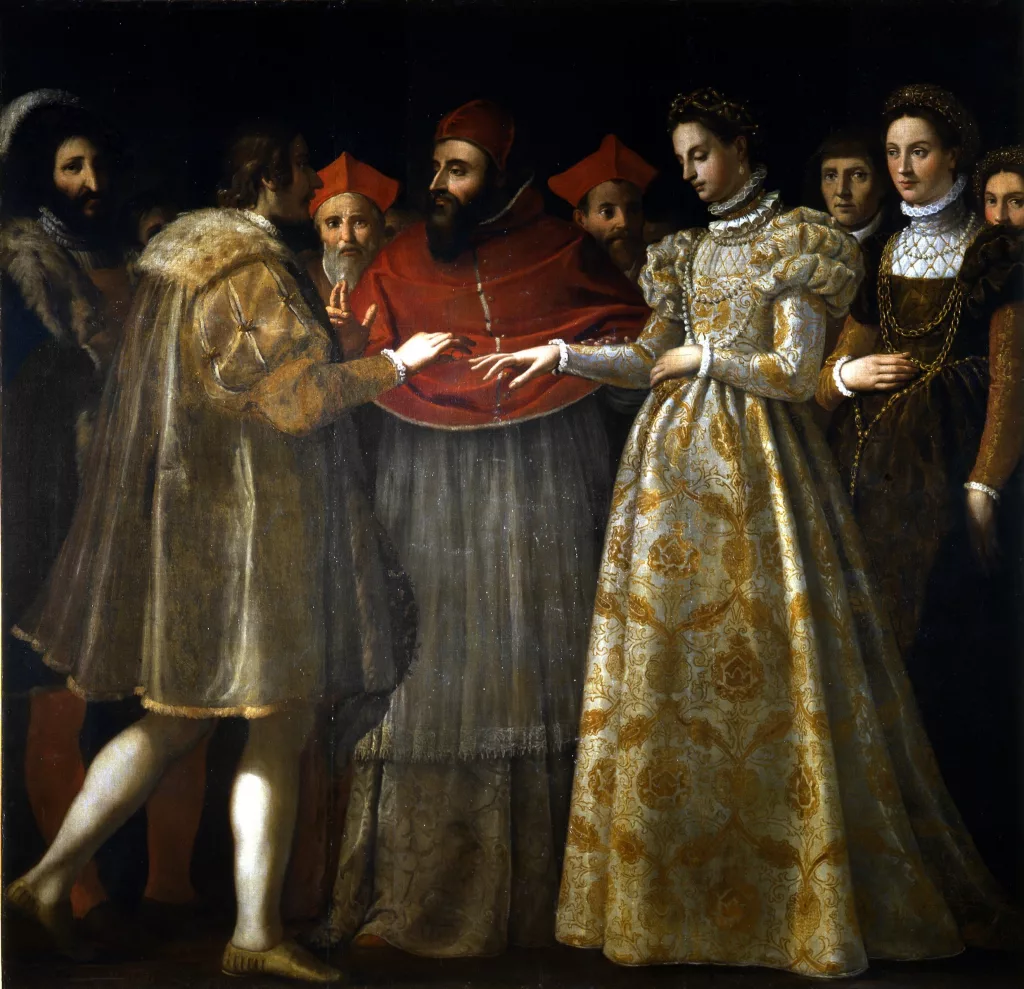
Enter Cosimo Ruggeri. The Italian gelato origin “story” is that he entered a competition sponsored by the de’ Medici court, a competition to prepare the best dessert known to man. Ruggeri, a chicken farmer by trade and a cook in his spare time, took part in the competition. Ruggeri’s frozen dessert was a forerunner of gelato and was called fior di latte, which translates as flower of milk. He won the contest and Caterina de Medici took Ruggeri with her to the French royal court to show how Italian chefs were superior to those in France. He made his specialty for her wedding to the future King of France and his creation became a success. Unfortunately, the chefs at the court, jealous of his connection to the Queen, despised Ruggeri. He soon tired of the palace intrigue and bid France goodbye, leaving Caterina with his recipe for fior di latte. While this is a nice story, it appears to be completely untrue. Food writer Elizabeth David claims in her book Harvest of the Cold Months that it would have been impossible for frozen sorbetto or sorbettos to be made at the French court at that time. Caterina’s Ruggeri was an astrologist and alchemist, not a cook. Some in the court accused both of them of sorcery. However we’ll continue with this more romantic cook story because it remains as a “truth” in modern retelling of the history of gelato. It could be a mix up of a name unknown cook Cosimo Ruggeri vs Cosimo Rugieri the alchemist. However the big story covers a lot of war and religious intolerance.
Ruggeri wanted to stay in his country but was forced to leave his kitchen and was put on a boat together with all the rest of the court of Caterina. They all left for Marseille in 1533. When the young queen arrived at her chambers in Paris, she ordered Ruggeri to put on a good show of his cooking fantasy so as to astonish (and also humiliate) the people dining at her table. By mixing all the techniques he had so far mastered, he created extremely elaborate ice-creams, both in shape and color, that left everyone speechless. At the same time, this caused envy and hate among all of those working in the royal kitchens. Ruggeri was courted by the most influent crowns of Europe; his fior d latte became something fashionable and because of this, Caterina didn’t want to lose her favorite cook. But, the more the approval and admiration of the court, the more hate and envy grew among his colleagues in the kitchens until it went from words to fists: at the beginning, cooks, helpers abandoned him, then they organized an ambush and one evening he was almost beaten to death. Ruggeri had enough of this and wrote a letter to Caterina: “Her Majesty, with or without your permission, I will go back to my chickens, hoping that people will leave me in peace, forgetting that I exist. They will continue to eat “my candiero” (then the name of gelato in Tuscany). So fantastically, fourteen year old Caterina brought to the kingdom of France a rich dowry of gold coins and pearls. And possibly, an even more interesting cultural treasure in various fields: from the art of the table and cuisine, to fashion and perfumery (a fragrance concocted for her with bergamots,l’Acqua della Regina, still available for sale today! https://us.smnovella.com/pages/acqua-della-regina).
This is the end of the chicken farmer legend. The real Ruggieri (written with “i”) was an alchemist and a famous astrologer named Cosimo. Cosimo worked for his queen for all his life but he was not a cook. At times she was accused of being a witch or worse on account of her reliance on his astrological predictions and influence. He was accused of poisoning people.
Meals at the French court of Caterina included the precursors of the French classics: onion soup, known then as carabaccia, and vegetables with béchamel sauce, salsa colla Her tables were decorated with precious cloths and the fork started appearing by the side of plates not just as a tool to portion food from the buffet but with which to eat. Forks were common across the Alps, but had not yet reached French tables. Meals started being served in courses. Savory and sweet were offered separately. Although the French take credit for the macaron, it was Catherine de’Medici who would order her Italian pastry chefs to make them for the elite of the Valois court. Back then they were nothing like today’s multi colored and flavored sandwiched cookies, but a small sweet made of almonds, egg white, and sugar, called “priest’s bellybuttons.” The name macaron followed in 1552 when French author François Rabelais, bon vivant and free thinker, associated the sweet with its creators, the Italians, those “maccheroni” eating people.
French cuisine wallowing in medieval in tradition was elevated into the Renaissance by an Italian commoner (though a very well connected commoner) who became queen. Sorbet as it became known in France was a frozen dessert for royalty but arrived much later in time than this story would have you to believe. It is a story that is retold in ice cream museums, but not accurate.
A close examination of historical records shows it is not possible according to historical timelines. However this may be possible. During the mid 1500s Cosimo I de’ Medici, elegant Lord of Tuscany, designated Bernardo Buontalenti (born in Florence one year after Caterina’s wedding) to organize special festivities, which could astonish a delegation of the King of Spain, in support of Cosimo’s intention to incorporate Siena in the dukedom. Bernardo Buontalenti, our renaissance man, directed shows and fireworks and set up a continuous parties like they were going out of style. He arranged lavish banquets, at the end of which he served a frozen cream to which he had added a very precious ingredient that was imported from the newly discovered Americas: sugar. The Spanish delegation was enthusiastic and began to investigate methods of storing ice at home in Spain. Everyone who helped him prepare the gelato left Florence armed with these new precious recipes, which they went on to prepare for other lords across the land, especially France and Spain. The Grand Duke hired a number of cooks who continuously prepared gelato. It was a frozen cream made with ice, salt (to lower the temperature), lemon, sugar, egg, honey, milk and a drop of wine. His cold cream was flavored with bergamot and orange. This sounds like the product of the non existent contest the non existent Ruggeri won. Buontalenti was an expert of the ice conservation. He had drawn some cold storage room both in the Boboli Garden and in the Cascine area. Near the Fortezza da Basso (Medici Fortress) there is a street called , “ice-house street”. That street owes its name to the cellars covered with isolating cork and wood panels, with a system of canes that let the thawed ice drain. In addition to this, Buontalenti probably even built a sort of manual whisk to whip up the cream. Do we know this for certain? No, not the whisk part but in light of all of his other inventions, it seems logical. https://www.uffizi.it/en/video/the-ice-houses-of-the-boboli-gardens.

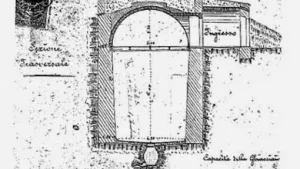
However, it could also be thanks to Caterina de’ Medici, then Queen of France, that gelato spread across Europe beginning during the second half of the century. She entertained many guests, kings and diplomats, who then returned to their homelands with the recipe. Is this true? Maybe….maybe. She died in 1589 and was the mother of three kings of France. Plenty of opportunity for banqueting, balls and diplomatic dining. She lived long enough to benefit from Bernando Buontalenti’s recipes and ice house designs.
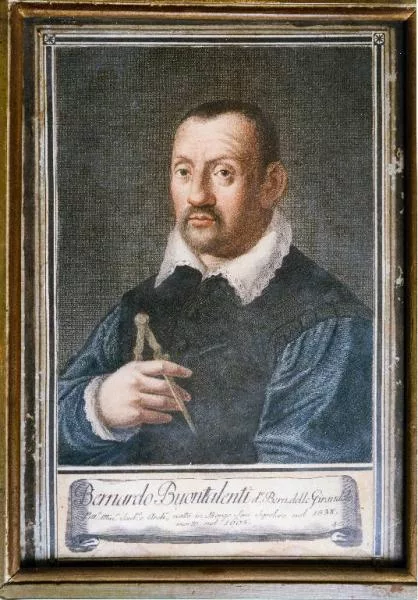
Bernando Buontalenti entered the service of the de Medici family as a teen employed by them his entire life – as an architect, stage and costume designer, fireworks technician, inventor of grenades in addition to frozen desserts. He is said to have studied under painters Salviati and Bronzino, sculpture by Michelangelo, architecture by Giorgio Vasari, and miniature painting under Giulio Clovio. He was frequently employed in the design of fortifications, villas, and gardens and is considered one of the most important architects of the era. This guy embodies THE RENAISSANCE MAN. His main achievements include the project for the new city of Livorno, the decoration of Palazzo Pitti and the Boboli Gardens with the famous grotto https://www.uffizi.it/en/artworks/grotta-del-buontalenti#gallery-2 (and ice storage). Buontalenti’s skills as a military engineer are shown by the fortifications of the port of Livorno, the Forte di Belvedere in Florence, the city walls of Pistoia, Grosseto, Prato, Portoferraio (Elba) and Naples; he also perfected designs for cannons, and devised a new type of incendiary grenade. I wonder how that coincided with the use of saltpeter to “freeze” liquids which is a process we’ll take a look at next installment.
RECIPE
This recipe is probably pretty close to Buontalenti’s. You don’t need an ice cream machine. There was no ice cream machine in his day. Of course you can add other flavorings and fruit to the mix.
400 ml fresh liquid cream
200 ml fresh milk
4 egg yolks
100 gr granulated sugar
1 vanilla bean
1/2 ungrated lemon zest
Bergamot is hard to find here so you have to do without. You can sub out part of the sugar for honey. Honey is considerably sweeter than sugar so just a little bit will do.
A pinch of salt
Method
Place a container, preferably steel, in the freezer to cool.
In a saucepan, pour the milk and cream with the split vanilla bean (scored in the center so the fragrant seeds infuse the flavor of vanilla into the liquid), then heat over moderate heat until almost boiling; add lemon zest, then turn off the heat. Whisk the egg yolks with the sugar until light and frothy, then pour in the hot liquid and mix well. Return to low heat for 5/6 minutes: continue stirring, making sure the mixture doesn’t boil or the eggs will curdle. Strain through a seive.
Let it cool completely.
Now pour the mixture into the chilled steel container and place it in the freezer for at least 3/4 hours, remembering to stir the ice cream every 30 minutes or so.
Bartolomeo Scappi ( 1500 – 13 April 1577) was a famous Italian Renaissance chef from Lombardy, according to the inscription on a stone plaque in the church of Luino. In April 1536, he organized a banquet while in the service of Cardinal Lorenzo Campeggio. He served several other cardinals after this, then began to serve pope Pius IV, entering the service of the Vatican kitchen. He continued to work as a chef for the pope Pius V. Scappi and became one of the first internationally renowned celebrity chefs.
L’Opera of Bartolomeo Scappi, or the “works” of Bartolomeo Scappi is a cookbook that was published in 1570, contains over 1,000 recipes, and was a bestselling cookbook for almost 200 years after its publication. Of course, I had to get this cookbook! I wasn’t disappointed. Besides the amazing food, within the pages I discovered the voice of Scappi, a man we know very little about, but the flavors and recipes are truly unforgettable. He declared Parmesan to be the best cheese on earth. I agree. Hundreds of ingenious kitchen tools and techniques are shown including the first known picture of a fork. We will talk about forks later, perceived by many to be instruments of the devil. Many of Scappi’s recipes have stood the test of time over the past 500 years while some are a little bit disgusting to the modern palate. Curious? Order a reproduction with translation from Amazon.
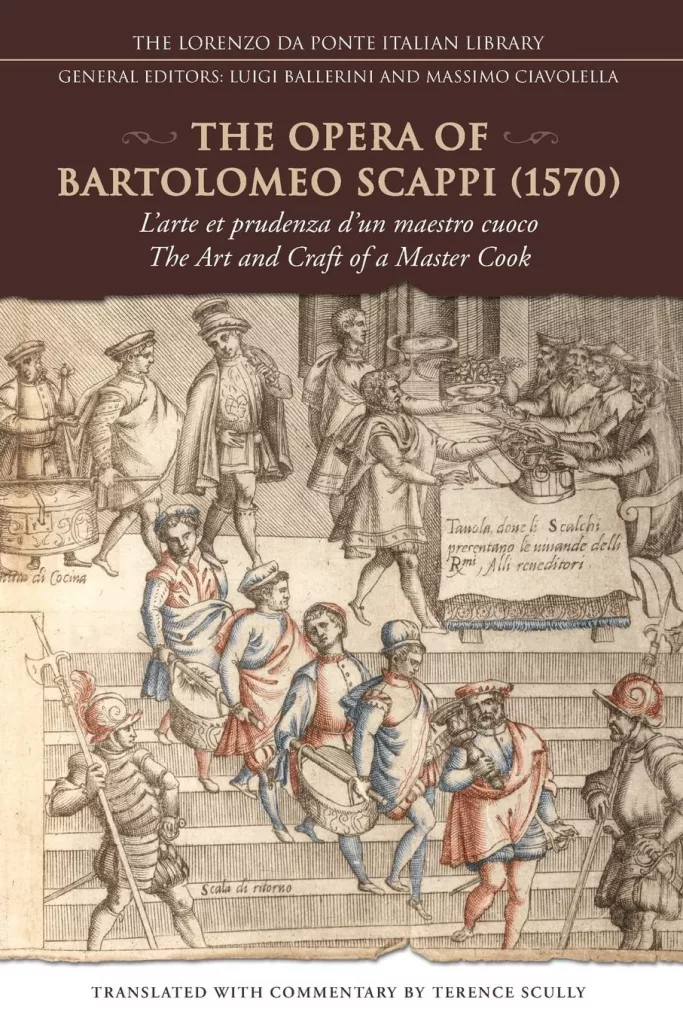
You can see that the mid 16th century was an important period of time in our history of frozen desserts reflecting advancements in science, changes in royal and religious dynasties.
We will pick this thread up again with the use of saltpeter to freeze drinks and desserts, another method of freezing that also made it’s way from China and India to the west.